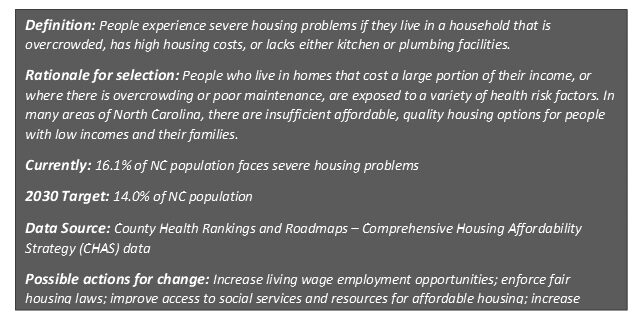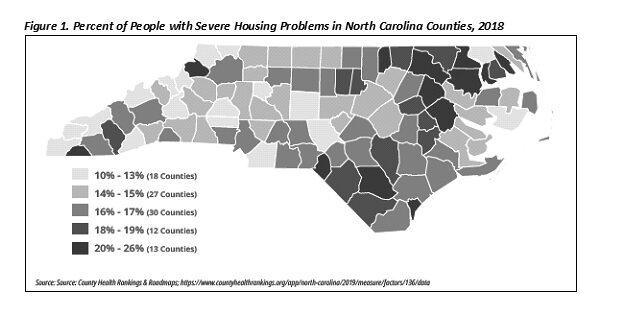

Written by Brieanne Lyda-McDonald
The recently released Healthy North Carolina 2030 health goals for the next decade reflect the broad range of factors that impact the health of North Carolinians. Throughout the coming year, we will feature the chosen health goals in a series called “A Path Toward Health.” For the first edition in this series, we’re highlighting severe housing problems.

There is a direct link between the affordability and quality of housing and physical and mental health. People who experience housing cost burdens (housing costs exceeding 50% of income) make critical decisions about spending on food, health care, and other necessities. These individuals may have few options besides living in low-quality homes in unsafe neighborhoods. These conditions can lead to high levels of stress and decreased use of health care for issues like chronic diseases. Approximately half a million North Carolinians suffer from housing cost burden.1
Housing cost burden can also contribute to another component of severe housing problems—overcrowding. Overcrowding is defined as having more than one person per room of a residence (not including bathrooms). Health consequences of overcrowding include chronic stress from space-sharing conflicts and exacerbated respiratory conditions, such as asthma. Approximately 14,000 households in North Carolina are overcrowded. 1
The final component of severe housing problems—lack of kitchen and/or plumbing facilities—can lead to untreated wastewater surfacing outdoors or backing up into homes, risking exposure to pathogens and contaminated drinking water. This wastewater surfacing can also provide breeding areas for mosquitoes and flies. People who lack kitchen facilities are more likely to experience food insecurity or poor nutrition, contributing to poor health outcomes such as diabetes and obesity. Approximately 24,000 households in North Carolina lack sufficient kitchen facilities and 18,000 households lack complete plumbing.[1]
Disparities in experiences of severe housing problems exist along geographic, racial, educational, and income lines. Metropolitan residents and racial and ethnic minorities are more likely than their rural and white counterparts, respectively, to face all components of severe housing problems. Figure 1 shows the distribution of North Carolinians facing severe housing problems by county.

In recent years, impacts of major hurricanes (Matthew in October 2016, Florence in September 2018, and Dorian in September 2019) have exposed the lack of safe and affordable housing in North Carolina. These housing vulnerabilities will continue to be a challenge in coming years if not aggressively addressed. The Centers for Disease Control and Prevention notes that the entire country has experienced a greater number of heavy precipitation and drought events in recent years, and these are projected to increase in all U.S. regions due to overall changes in the climate. In addition to housing challenges, these events, coupled with increasing temperatures, are projected to lead to rising sea levels, lower crop yields, reduced livestock productivity, and higher risk of heat-related and respiratory illnesses.
The North Carolina Institute of Medicine will center our 2020 Annual Meeting on the topic of preparing for the health impacts of a changing climate. Topics of discussion will take a broad look at how communities can prepare for the impact of a changing climate on health, including the impacts of weather events on housing quality and availability. More information about the Annual Meeting this fall will be coming soon.
[1] Estimates based on NCIOM analysis of data from the American Community Survey and County Health Rankings and Roadmaps.